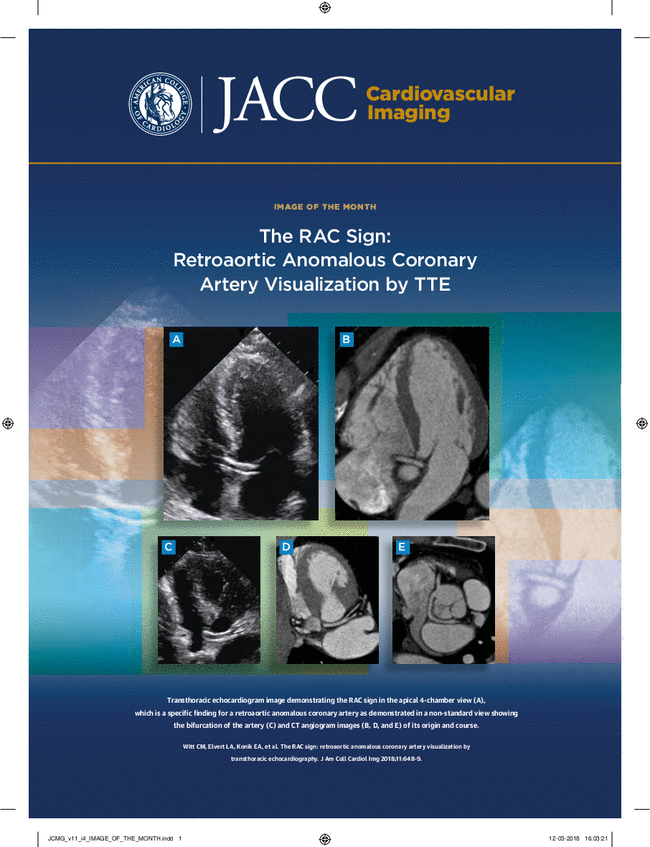Evolocumab对冠状动脉PET和CT血管造影显示的冠状动脉斑块组成和微钙化活性的影响。
IF 15.2
1区 医学
Q1 CARDIAC & CARDIOVASCULAR SYSTEMS
引用次数: 0
摘要
背景:evolocumab对正电子发射断层扫描(PET)和冠状动脉计算机断层扫描血管造影(CTA)的潜在冠心病活动性和冠状树斑块组成的影响尚未被描述。目的:这项前瞻性影像学研究旨在评估evolocumab治疗后冠状动脉CTA和冠状动脉微钙化(斑块活性的标志物)在18f -氟化钠(NaF)正电子发射断层扫描(PET)上的斑块组成变化。方法:这项单臂、前瞻性、开放标签的研究纳入了通过冠状动脉CTA测量的基线广泛非钙化斑块体积(整个冠状动脉>440µL或任何单个斑块>250µL)的患者。所有参与者进行了基线和18个月的随访冠状动脉CTA和18F-NaF PET。用18F-NaF PET通过病变水平的最大靶本底比和整个冠状动脉树的冠状动脉微钙化活动来评估疾病活动性。结果:共研究47例患者(年龄61.8±10.1岁,男性87%),196个病变。23例(48.9%)无症状,16例(34%)表现为胸痛,8例(17%)表现为呼吸困难。4例(8.5%)患者既往有冠状动脉病史。平均随访18个月,总斑块体积无显著变化(716.2±431.4µL至710.8±456.2µL,差值为5.4±97.4µL;P = 0.705)。观察斑块组成的变化,非钙化斑块显著减少(607.3±346.8µL)至562.1±337.3µL,差异:45.2±63.8µL;P < 0.001)和低衰减非钙化斑块(37.1±28.9µL至20.4±15.4µL,差值:16.6±23.5µL;P < 0.001)。相比之下,钙化斑块从108.9±133.7µL增加到148.7±175.3µL,差异为39.8±56.1µL;P < 0.001)。冠状动脉微钙化活性显著降低(1.35±1.68 ~ 1.08±1.37);P = 0.004),病灶目标-背景比(1.73±0.85 ~ 1.62±0.83 P = 0.005)。结论:在基线时具有广泛非钙化斑块体积的稳定患者中,18个月的evolocumab治疗与向低风险定量斑块表型转变和微钙化活性降低相关。Evolocumab对冠状动脉粥样硬化的影响;NCT03689946)。本文章由计算机程序翻译,如有差异,请以英文原文为准。
Effects of Evolocumab on Coronary Plaque Composition and Microcalcification Activity by Coronary PET and CT Angiography
Background
The effects of evolocumab on the underlying coronary disease activity by positron emission tomography (PET) and coronary tree plaque composition by coronary computed tomography angiography (CTA) have not been described.
Objectives
This prospective imaging study aimed to evaluate changes in coronary plaque composition on coronary CTA and coronary microcalcification, a marker of plaque activity, on 18F-sodium fluoride (NaF) positron emission tomography (PET) after evolocumab treatment.
Methods
This single-arm, prospective, open-label study enrolled patients with baseline extensive noncalcified plaque volume by coronary CTA (>440 µL overall coronary artery or >250 µL in any single plaque). All participants underwent baseline and 18-month follow-up coronary CTA and 18F-NaF PET. Disease activity was evaluated with 18F-NaF PET by maximum target-to-background ratios at the lesion level and by coronary microcalcification activity for the entire coronary tree.
Results
A total of 47 patients (age 61.8 ± 10.1 years, 87% male) and 196 lesions were studied. Twenty-three (48.9%) patients were asymptomatic, 16 (34%) presented with chest pain, and 8 (17%) presented with dyspnea. Four (8.5%) patients had a prior coronary artery disease history. At a mean follow-up of 18 months, there was no significant change in total plaque volume (716.2 ± 431.4 µL to 710.8 ± 456.2 µL, difference: 5.4 ± 97.4 µL; P = 0.705). Changes in plaque composition were observed, with a significant reduction in noncalcified plaque (607.3 ± 346.8 µL to 562.1 ± 337.3 µL, difference: 45.2 ± 63.8 µL; P < 0.001) and low-attenuation noncalcified plaque (37.1 ± 28.9 µL to 20.4 ± 15.4 µL, difference: 16.6 ± 23.5 µL; P < 0.001). In contrast, there was an increase in calcified plaque (108.9 ± 133.7 µL to 148.7 ± 175.3 µL, difference: 39.8 ± 56.1 µL; P < 0.001). There was a significant reduction in coronary microcalcification activity (1.35 ± 1.68 to 1.08 ± 1.37; P = 0.004) and lesion target-to-background ratio (1.73 ± 0.85 to 1.62 ± 0.83; P = 0.005).
Conclusions
In stable patients with extensive noncalcified plaque volume at baseline, 18 months of evolocumab treatment was associated with a shift toward a lower risk quantitative plaque phenotype and reduction in microcalcification activity. (Effect of Evolocumab on Coronary Atherosclerosis; NCT03689946).
求助全文
通过发布文献求助,成功后即可免费获取论文全文。
去求助
来源期刊

JACC. Cardiovascular imaging
CARDIAC & CARDIOVASCULAR SYSTEMS-RADIOLOGY, NUCLEAR MEDICINE & MEDICAL IMAGING
CiteScore
24.90
自引率
5.70%
发文量
330
审稿时长
4-8 weeks
期刊介绍:
JACC: Cardiovascular Imaging, part of the prestigious Journal of the American College of Cardiology (JACC) family, offers readers a comprehensive perspective on all aspects of cardiovascular imaging. This specialist journal covers original clinical research on both non-invasive and invasive imaging techniques, including echocardiography, CT, CMR, nuclear, optical imaging, and cine-angiography.
JACC. Cardiovascular imaging highlights advances in basic science and molecular imaging that are expected to significantly impact clinical practice in the next decade. This influence encompasses improvements in diagnostic performance, enhanced understanding of the pathogenetic basis of diseases, and advancements in therapy.
In addition to cutting-edge research,the content of JACC: Cardiovascular Imaging emphasizes practical aspects for the practicing cardiologist, including advocacy and practice management.The journal also features state-of-the-art reviews, ensuring a well-rounded and insightful resource for professionals in the field of cardiovascular imaging.
 求助内容:
求助内容: 应助结果提醒方式:
应助结果提醒方式:


